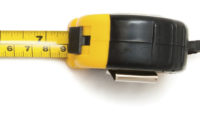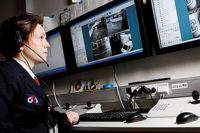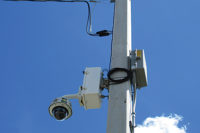
A license plate is essentially the DNA of a vehicle. It can tell you who owns the vehicle, where they live, whether they have a criminal record, whether their license is suspended and much, much more. Perhaps that best explains why license plate recognition (LPR) technology is becoming more widely used.
What LPR does seems fairly simple and straightforward. It takes a photo, reads a license plate from that photo, then stores and/or analyzes that plate against a list of specific plates. However, a peek under the hood reveals the process is anything but simple and straightforward.
LPR systems consist of two essential components: Image capture technology (camera) and analytic software, which includes algorithms and optical character recognition. Depending on the application, a system may also include a third component, automated software that compares identified license plates against an existing database (registered vehicles, arrest warrants, etc.).
These systems are generally deployed using two approaches. The first involves image capture at a site, with video transmitted to another site where it is run through analytic software. The second is to perform both image capture and analytics “on the edge” at the deployment site.
The ‘Eyeball’ Of The System
As is the case with any video surveillance system, the results that come out of image capture are only as good as the camera itself. When it comes to LPR, with its algorithms and analytics, never has the expression “garbage in, garbage out” been more true, says Paul Bodell, chief marketing officer for IQinVision, San Juan Capistrano, Calif.
Put another way, the camera is the “eyeball of the system,” in the words of Raul Calderon, vice president of marketing for Glendale, Calif.-based Arecont Vision. Good quality lenses and high megapixel counts make for a better eyeball. The better the eyeball, the better the analytics and — by extension — the better the results.
The difference between regular definition and high definition (1.3 megapixels and up) can be staggering, Calderon says. For example, Calderon confirms that a typical VGA camera captures images at 0.3 megapixels. For the best performance, LPR software typically requires the camera to use anywhere from 40 to 90 pixels per horizontal foot of coverage. So at 45 pixels per foot, that 0.3 megapixel camera can provide 14 feet of coverage. However, a 3 megapixel camera at 45 pixels per foot will give you 42 feet of coverage. For a tollbooth application, that can mean the difference between having a camera cover one or two lanes, rather than five or six.
Of course, Bodell notes, for some applications — particularly those where missing a license plate can mean missed revenue — an end user could choose to cover the same 14-foot field-of-vision and get an image that is 10 times more detailed with the higher-megapixel camera.
As you may imagine, light also plays a major role in the LPR process. The camera has to be able to recognize a license plate with enough detail for analysis in all kinds of lighting: sun, rain, snow, dark and with headlights aimed in the camera’s direction. According to Chris Yigit, AutoVu LPR product manager for Montreal-based Genetec, any camera used for LPR needs some sort of illumination.
A common type of illumination used by cameras is infrared LED, which filters out any ambient light and replaces it with controlled lighting. The IR reflects off the license plate to enhance the view of the plate and ensures a good read regardless of lighting conditions. Some cameras, including those produced by Genetec, include both an IR camera and a contextual camera. For cameras that do not include on-board IR illumination, external IR sources, such as those offered by Illuminar, can be coupled with a camera to provide the same “all-hours” lighting quality.
While the IR ensures the best possible look at the plate, Yigit says a system should include a contextual camera as well, to capture an image of the vehicle, its surroundings, time of day and more — to provide a complete picture of what occurred or is occurring in real time.
Feeding The Algorithm
Once a camera has captured an image, the very complex back-end processing with its intricate algorithms and optical character recognition (OCR) begins. If the camera is the eyeball of the LPR system, then the analytic software is its heart.
The first stop for an image is the analytical software. Based on pre-programmed algorithms, the software determines which objects within the image look like a license plate. Next, the software’s OCR capability must identify and read the characters located within the image (or images) that the algorithm identified as license plates. The goal is to convert plate images into data that can be either archived for future reference or can be compared against a database. Because all license plates in North America are roughly the same size, it may be surprising that this is often the most difficult part of the process.
“We love our variety,” Willem Ryan, product marketing manager – LP cameras for Fairport, N.Y.-based Bosch Security Systems Inc., says of the variations in license plate designs not only from state to state, but within a state as well. Differences in color, fonts, character placement, positions of letters and numbers, and more can create serious problems for even the most sophisticated algorithms. Most software providers employ a highly skilled team of programmers who work to come up with any possible variation and feed it into the algorithm.
“In reality, it’s a very finicky process,” Yigit says. “Basically, they’re teaching a computer to read [despite the variables].”
Once the algorithm targets in on a license plate, the OCR software converts the image into text for digital processing. Of course, the quality of the captured image has a huge bearing on the information the software can extract. At the point of processing, depending on the application, the data can be reviewed by a person or can be run through a database automatically to determine if there is any reason to send an alert. Should there be a match, the appropriate person can be contacted or alerted.
What Are The Applications?
First developed in 1976, LPR technology has come a long way since the first arrest — and subsequent stolen car recovery — was made as a result of LPR in 1981. While it’s been used in traffic and law enforcement applications for many years, the technology has come a long way in the last 30-plus years.
Advances in technology have taken LPR systems from fixed applications, such as toll plazas, to mobile applications. For example, when a police officer pulled someone over 10 years ago, he or she would enter the plate number into a computer, then wait. As Yigit says, the officer might have been able to scan 10 to 15 plates a day under the old system.
Anyone who has ever received a traffic ticket complete with a photo of their car in the mail can attest to the quality and efficiency of the systems in use in the marketplace.
While transportation and law enforcement may be obvious applications for LPR, they are not the only possibilities. Today, Ryan says, customers are seeing more of a need for LPR in smaller security-based applications. For example, LPR can be used to control an access point, such as a parking lot or a parking garage where parking is allowed by permit only. License plates can be compared against a white list of vehicles to determine whether a vehicle should be allowed to enter. This can be done manually, with a person opening or closing a gate, or LPR can be integrated with an access control system to perform the task automatically.
Systems integrator UCIT Online Security, based in Mississauga, Ontario, has had success in using LPR technology at sites where it provides video monitoring. Most notably among these are construction sites, where vandalism and theft are widespread. At each site, UCIT installs Bosch Security’s REG License Plate Capture cameras to provide plate images for every vehicle that enters or exits that site. To date, LPR has played a key role in the identification and arrest of two suspects per week (on average) at UCIT-monitored sites.
Whether LPR is right for a particular situation depends on a number of factors, Ryan says. The first of these is the situation itself. If someone were looking for LPR for a single entrance, and simply wanted to archive data for later review, then a lower-resolution camera might be the best bet, he says. But a more complex situation with variables such as speed and lighting most likely calls for a more robust system.
The second factor is cost. In revenue-capturing applications (toll booths, traffic tickets, etc.), every person who “gets away with something” costs money. For those applications, the most robust — and most expensive — system is certainly justified.
But just as a larger system may not be necessary for the particular application, there are also situations where a more expensive system can’t be justified from a business sense.
Does it Work?
For the most part, the effectiveness of LPR systems is greatly increased when people follow the instructions and have realistic expectations, says Todd Pinnell, video product manager for Speco Technologies, Amityville, N.Y. If, for example, someone thinks they’ll be able to get a 100 percent positive read rate on vehicles traveling at 180 miles an hour from a very long distance, that person will be sorely disappointed in LPR.
Before doing anything, find out what the customer’s goals are. That includes the required capture rate, the required recognition rate and how images are going to be used. When discussing capture and recognition rates, it’s important to note that, as Ryan says, there’s no such thing as 100 percent for all states and provinces. A very good system will capture only 85 to 90 percent of the license plates that pass through the camera’s field-of-vision. Recognition rates will depend on the quality of the image, which goes back to the camera and the software used in the system.
Customers also need to understand that, mainly because of the different plates around the country and the world, LPR software is not plug-and-play, so it’s not a matter of loading a CD and being up and running. “It will take some time to tweak the software to be acceptable,” Ryan says.
But, Bodell says there is no time like the present to learn about and educate customers about LPR. As the technology and reliability go up and price comes down, he says, LPR should become more widely accepted. He envisions the potential for LPR to be in every police car, in buses for monitoring nearby vehicles, automated rental car returns and more.
Technology in Action
Earlier this year, the Memphis Police Department used grant money to install Genetec LPR technology on several cruisers as part of its ongoing Blue C.R.U.S.H. initiative to fight crime and get criminals off the streets.
Using LPR, officers park on the side of the road just as they would to monitor for speeding violations. The cruiser-mounted IR scans for license plates, checks them against “a couple million” records in about half a second, and audibly alerts the officer about plates that have been flagged.
The program has been successful, according to Genetec’s Chris Yigit. But don’t take his word for it. The Memphis Fox TV station produced a news segment on the department’s LPR systems. In it, two people who were “caught” by the system express their amazement at how well it works. The video also provides useful insight into how an LPR system functions.
To watch the video for yourself, go to http://www.youtube.com/watch?v=ofa8pObwyr0.





